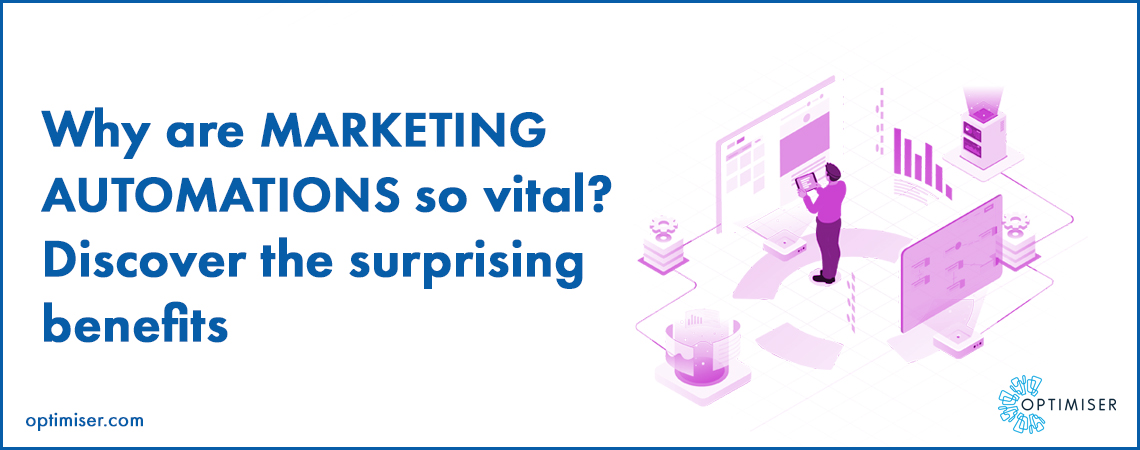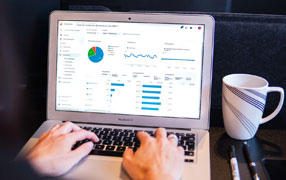
Why are marketing automations so vital? Discover the surprising benefits
How can automations be applied to marketing?
What are the benefits to automations in marketing?
How Optimiser’s marketing automations work
Marketing automations are the secret tools that most strong competitors will be using to: create excellent marketing strategies, utilise resources cleverly, and allow their business to compete on a global level. Find out exactly how marketing automations will benefit your business, and why they should make up a vital part of your digital strategy.
As humans have found more ways of communicating with one another, marketing to an audience has become increasingly expansive. Where marketing activities used to be split down a digital and physical divide with just two strategies to implement and manage, the digital avenue now requires even further divisions, each with their own unique targets and strategies:
- Email marketing
- Social media marketing
- SEO (Search Engine Optimisation) marketing
- PPC (Pay Per Click) marketing
- Content marketing (video, text, image)
It is now more apparent than ever that each distinct marketing channel, if well maintained and monitored, will help you reach a unique section of your target audience demographic, each with its own unique buying intent.
In order to achieve the maximum possible effect from all of these channels, while maintaining staff time and marketing resource management, automations are the key consideration that can save valuable time on manual and repetitive processes.
What are automations?
Broadly speaking, automation is a team used to refer to any IT software or process that is self-directed, in other words where the need for human intervention has been reduced and handling is either completely or mostly automatic rather than manual.
Due to the fact that the technology is becoming increasingly affordable, companies of all sizes can employ the use of automated technology. Basic automations have become routine in the management of the average business’s every day processes, mostly for tasks that are formulaic, predicted, or repetitive. By taking marketing tasks from the customer journey that are automatable, teams will find a reduction in their daily maintenance tasks, such as: forecasting, predictive lead scoring, prospect nurturing, contact frequency analysis, data cleaning and workflow streamlining- resulting in an increase in available time resources.
How can automations be applied to marketing?
To implement automations, you must first have a storage or live source of information collection. This can come from any activity generated across every touchpoint your brand has: each time someone makes a purchase or sale, visits your website, subscribes to your newsletter or clicks an advert in an email or social media post. This valuable data allows you to gain in-depth knowledge of your business performance as a whole, including who you audience is, where they are, contact frequency, their interests, and even financial capacity for future purchasing.
Secondly, marketing automations require instructions. For example, when a specified audience segment, contact or lead does a certain action, it triggers an automated response. When a prospect begins to fill in a contact form and clicks away from the page before clicking send, do you want them to receive a reminder to get in touch with you via email? Or, when a person within a particular focus group signs up to your newsletter, do you want to direct them straight away to a running campaign?
Instructions should include who you are trying to target, what activity should trigger the automation, and what action you’d like to happen when the automation is triggered.
.jpg)
What are the benefits of automations in marketing?
There are a multitude of benefits to marketing automation, the first and perhaps most obvious being saving time and resources. All marketers know that a large percentage of the role is attempting to re-engage prospects that have gone quiet, or leads that have leaked somewhere in the user journey. By engaging with an audience who have already shown an interest in your product or service, your marketing is likely to result in higher value leads being passed along to the sales team. This also saves time and leads to a higher focus on tasks with more importance.
When you have automations to collect and interpret your data, you can create increasingly complex instructions that cover every section of your audience, every touchpoint and every KPI. By doing so, you enable your business to capture even more data, expand the reach your products and services are having, and better target using focus campaigns that score bigger and better deals.
Automations help you to better understand your customers and audience. There is tonnes of insight into your company, product and service if you dig more into what your company data is telling you. Automations can produce reports on what marketing is gaining you the most attention, where visitors are clicking on your website, where they originate from. It can also shed light on more personal information like your audience’s financial status, purchase history, demographics and what is referred to in GDPR as “sensitive data”.
“Amazing things will happen when you listen to the consumer,”
Jonathan Midenhall
How Optimiser’s marketing automations work
.jpg)
Email automation
If you are already familiar with any type of automation, it is likely to be this one. Email automations are triggered to send a pre-set email to users having completed a certain chain of actions. Some common ones are:
- Add product to shopping basket > Leave the page without purchasing > Product reminder email or deal code triggered
- Begin to fill in a contact for on the website > Abandon page without sending > “Please get in touch” nudge-email sent
- User signs up to be a part of your mailing list > Receive a welcome email and discount code
- User purchases a product from you > You get a notification from the delivery company that it has been successfully received > “Please leave a review” email triggered
Email automations are a great way to stay connected with your audience and client without needing to input any manual effort at all. Optimiser’s email marketing allows you to make creative and stylised mailers with no need of knowledge about HTML coding.
Using the simple drag and drop function, place areas for text and images in your design either using a preset template or building your own. Add branding and links from the simple editor function and you’re good to go on all your automated email campaigns!
If you are a global enterprise, the smart scheduling automation function is especially useful as you can target customers in different territories at the local times most useful for them.
Customer journey
Automations in the customer journey follow a similar logic to email automations, only they apply to anywhere the customer can interact with your brand online. By collecting data and creating a comprehensive engagement map, you can tailor ad placements and landing page content to meet the specific interests of your target group.
Based on the data you collect from the engagement map and customer journey, you can then create website funnels that get your most engaged audience to the sale stage with the fewest steps possible. One way to do this is by optimising and recommending products that will increase revenue thanks to resource-saving “proxy sales”. Use purchase history to guide audience grouping and further email automations personalised to the unique tags applied to the users in that demographic.
Optimiser is a comprehensive CRM software company, providing businesses a customisable solution to their personal goals for sales, productivity, and growth. Powerful integrated modules include lead management software, a B2B sales toolkit, automated marketing suite and more for sale under a single subscription. Try Optimiser’s CRM software demo with access to the full Enterprise Licence FREE for 30 days, and find out how you can skyrocket productivity in just one month!

30 days free trial. No credit card required
 One powerful platform
One powerful platform
 Simple to use
Simple to use
 Comprehensive
Comprehensive



